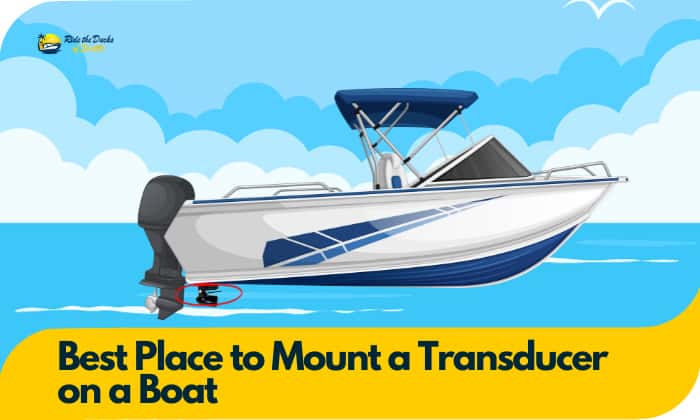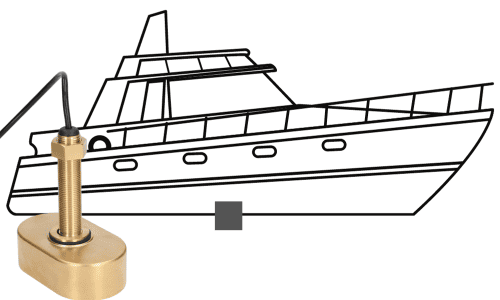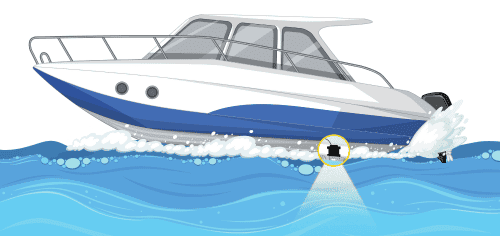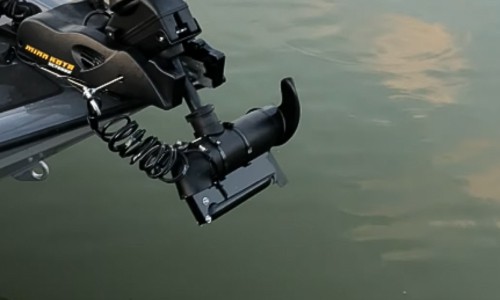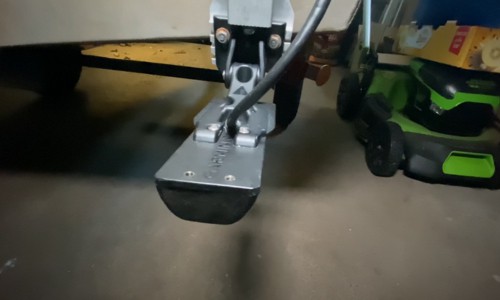If you want to get the best out of your transducer, you ought to know the best place to mount a transducer on a boat. The truth is, it’s often ideal to mount it on a flat surface, preferably the transom, to avoid the turbulence disrupting its signal sending and receiving.
The mounting height is dependent on the transducer’s manufacturer, so check your manual before installing.
With that said, we have conducted a list of the best mounting location for transducers with boat types in mind, as well as some installation tips. Stay tuned!
Table of Contents
Where to Mount a Transducer on a Boat?
1. Thru-hull
Thru-hull transducers are known for their accurate depth reading and better echo returns.
As its name suggests, a thru-hull transducer will be installed through a hole in the hull, ideally near the hull’s centerline or aft midship. With inboard-driven vessels, mount fish finder transducer forward of the propeller.
On outboard vessels and fin-keel sailboats, put the transducer in front of the engine or one foot in front of the fin keel, depending on which design you have.
Recommendations for other boats are as follows:
- In front of the first step for stepped hulls
- In the middle of the ship and away from the keel for full-keel sailboats
- At the ⅓ point of the load waterline length and at least six inches from the boat’s centerline (for displacement hulls)
And inboard of the lifting strakes for planing hulls (the strakes help displace water and are evenly spaced from both sides of the vessel’s body)
Some designs allow installation without a hole. If you’re buying one that does require drilling, the installation process will be somewhat more complex than other types.
2. Shoot-thru-hull
Shoot-thru-hull transducers, also known as in-hull types, stay mounted inside the hull, promoting better resistance against damage.
Just like thru-hull transducers, they work best when mounted near the hull’s centerline and toward the aft end, in the bilge, near the keel and transom.
Most of the time, shoot-thru-hull transducers are only used on fiberglass boats with solid hulls up to 0.75 inch thick.
3. Trolling Motor
A trolling motor transducer provides straightforward installation, as you only need to clamp it where you want to place it.
The best position to install this equipment is inside your boat’s propeller hub, on the trolling motor’s shaft for forward-facing transducers; on the motor’s barrel for down-imaging models; and on the transom, parallel to the waterline for side-imaging options.
4. Transom Mount
Transom transducers are best mounted on transom of small vessels (under 27’). Specifically, opt for a spot that is least affected by the water or nearby boat parts like propellers.
Ideally, the transducer position should be as close to the boat’s center as feasible and flush with or ⅛ inch below the hull bottom. Also, maintain a distance of at least 15 inches between the transducer and propeller.
5. Portable Mount
A portable transducer makes adjusting its placement hassle-free, allowing you to move it from one vessel to another with ease. It can be placed anywhere, but ideally, you’ll find the best position at the transom for ultimate performance.
Transducer Installation Tips
- The transducer location decides its working efficiency, so try to find a spot that is least affected by impacts or any factors that cause interference, such as electronic devices or another transducer.
- A mounting plate comes in handy in case you don’t want to use adhesive or drill holes in your boat.
- Choose a transducer type with your boat type in mind to make the most of its proficiency. For example, shoot-thru-hull transducers are often seen on fiberglass boats, whereas thru-hull transducers mostly appear on large-sized vessels like yachts.
- Try not to mount a transducer too low (with the transducer’s edge protruding more than 1/16 inch beneath the hull bottom), as it can interfere with sonar imaging.
Conclusion
By now, you should know the best place to mount a transducer on a boat.
Most installation manuals suggest keeping the transducers’ wires away from other wires and cables to mitigate any potential interference.
With its ability to provide accurate sonar readings of the underwater world, having a transducer on your vessel can help level up your boating adventures to a great extent.

Ten years of enjoying countless trips on boats never made me love them any less! So I am here to put all those experiences into good use for other boaters who want to have a safe and fun trip with their friends and families.

